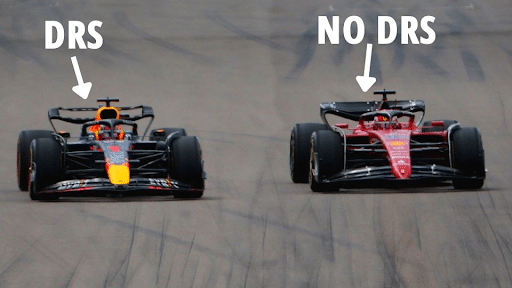The Secrets of the Aerodynamics in Modern F1 Cars

We are not strangers to the changes such things as cars, planes, and boats go through; a couple of hundred years ago, our primary transport was horses and steam trains. In today’s article, we will focus on the world of cars, especially those in Formula 1.
The first automobile was created on January 29, 1886, by Carl Benz. It was very simple in our view but a great step for humanity. By 1950, in just 64 years, we moved from a simple version to one with a powerful engine, great aerodynamics and traction. It was the Alfa Romeo 158 built by the Italian engineer Gioachino Colombo. This was the first Formula 1 car, the precursor in this industry full of adrenaline and speed.
<iframe width=”560″ height=”315″ Formula 1 cars, explained for rookies (with Max Verstappen) title=”YouTube video player” frameborder=”0″ allow=”accelerometer; autoplay; clipboard-write; encrypted-media; gyroscope; picture-in-picture; web-share” referrerpolicy=”strict-origin-when-cross-origin” allowfullscreen></iframe>
The Basics of F1 Aerodynamics
Let’s start with the aerodynamics. Simple, it is about the way objects move through the air. The principles of aerodynamics, for example, explain how airplanes can fly. In fact, forces affect everything that moves through the air, from launching rockets to kicking soccer balls. Since we are surrounded by air, even cars are influenced by aerodynamics.
In a few words, it is pretty complicated how the car moves itself through the air. For us to be precise, we will explore different parts of cars and their functions in terms of aerodynamics:
Front Wing: Generates downforce and channels airflow around the car.
Rear Wing: Provides significant downforce and stability, especially in high-speed corners.
Diffuser: Located at the rear underside, it accelerates airflow under the car to enhance downforce.
Sidepods: Shaped to direct airflow to key aerodynamic regions and aid in cooling.
Bargeboards: Installed between the front wheels and sidepods to clean up turbulent airflow.
Undertray: Smoothens airflow under the car, working in tandem with the diffuser.
Front Splitter (Nose Cone): Directs air over and around the car while contributing to downforce.
Ducts and Vents: Optimized for cooling without disrupting aerodynamic efficiency.
T-Wing: Mounted above the rear wing for additional aerodynamic benefits.
Halo: A safety device with aerodynamic considerations to minimize drag.
DRS (Drag Reduction System): A movable flap on the rear wing used to reduce drag.
In the front part of F1 cars, we can see a low and pointy structure that looks like a hammerhead shark, also called the Front wing, which helps the wind curve upward, making the air move in a certain way so a high-pressure area forms above the car and a lower pressure area beneath. This helps to create a suction force called “downforce” that makes the car stick to the track.
If you are thinking of examples, here it is: planes create pressure under the wings so they will lift in the air. In cars, it is the other way around.
When both pressures connect at the end of the front wing, high-pressure and low-pressure mixes, creating a spiraling vortex; these vortices cause drag, which causes the car to slow down. Therefore, it is commonly used in cars as a cap so the vortex won’t form at the end of the wing. However, not all of them are bad; some under the floor of the car are good because they seal the air flowing under the vehicle, which may be used for different purposes.
Since the cars in F1 don’t have fenders like our day-to-day cars, this causes something called “dirty air,” which is not very useful for aerodynamics and can cause problems and even more drag in the car. The bargeboard is placed on the sides of the vehicle helping push the dirty air away from the body.
The key to downforce is always keeping the high pressure above and light. For this aim, a diffuser at the rear of the body increases the airflow usage due to its curvy form.
All modern machinery from computers and phones to cars needs cooling. In race cars, the sidepots work as this cooling system. All clean air goes through the sides into the sidepots and travels through all the cars.
In the rear, we will find the iconic rear wing, another contributing factor to downforce generators, whose curvy form helps the air pass through but also creates a vortex behind it. Above this, we will find a small piece of engineering, a DRS or Drag Reduction System, and a hydraulic flap that helps create either a downforce or higher speed.

Key Components Shaping F1 Aerodynamics
High-speed and close curves are the challenges of F1 drivers because obtaining a perfect aerodynamic balance is essential for the vehicle’s overall efficiency. Teams and engineers need to find a perfect or almost perfect balance between downforce and drag so that the car gets a good grip while maintaining speed.
While we are here, don’t forget to visit 1xBet page. Fans of races like the Grand Prix can watch live transmission of performances with favorite drivers and teams like Red Bull and Mercedes. Remember, if luck is on your side, you could even win extra money while cheering on your chosen driver.
Now, let us guide you through the three primary aspects of aerodynamics in Formula 1.
Front Wing Design
That is the primary technique utilizing the vehicle’s wings. Even though they are called front and rear wings, they aim to ensure the car stays in contact with the ground.
Bernoulli’s Principle states that varied air speeds near the car cause a pressure difference. When airspeed rises, pressure drops, leading the car to shift towards the region of lower pressure, which creates a downward force. The tilted wings generate reduced pressure beneath, applying downward pressure. These wings produce around 70% of the vehicle’s total downforce, essential for driver safety and efficient handling.
Rear Wing Mechanics
The function of the rear wing is to make better aerodynamic performance. However, it also serves other various purposes, such as the creation of downforce and the pressure to push the rear tires to the road.
Nevertheless, the rear wing also contributes to the vehicle’s total drag, which may impact its speed on straight roads. In general, increased downforce wings result in higher drag, which can decrease a car’s speed on straight sections of the track. Therefore, teams use smaller rear wings at tracks with many straight sections to minimize drag and achieve higher top speeds.
The Floor and Diffuser
The floor and diffuser parts of an F1 vehicle produce a large amount of downforce while keeping drag to a minimum. The underbody generates a vacuum effect below the vehicle, which helps keep it close to the ground, and the diffuser enhances the airflow under the car to minimize disruption. Combined, these parts help improve the overall performance and stability of the vehicle, particularly in crucial corners that require good grip. 
The Role of Computational Fluid Dynamics (CFD) and Wind Tunnels
Let’s grab our seats. This is quite a complicated part inside of the aerodynamics arena.
Computational Fluid Dynamics, also known as CFD, utilizes computers to replicate fluid flow (like air and water) over digital models made by Computer-Aided Design (CAD) software. The CFD analysis techniques allow direct simulation of full-size models. Utilizing CAD models allows CFD to replicate flow over virtual models, eliminating the expense of creating physical ones.
The wind tunnel has played a crucial role in analyzing aerodynamic performance ever since the Wright brothers (inventors of the first airplane) used one to assess their airfoil profiles during the early days of powered flight.
A wind tunnel mimics the flow of air around an object (like an airplane or a car) by putting a mini version of the object in a duct and either blowing or sucking air through it. Attaching the model to a force balance enables the assessment of forces like drag, lift, or downforce caused by the air interacting with the scale model.

Managing Drag and Downforce: The Balance of Speed and Control
It is commonly known that F1 cars are so fast because of their aerodynamics or, in simple words, the car’s shape, but the trick lies in making the car work around the shape given.
The two major forces in play are the downforce and drag. Both of these make the car faster and easier to control or slower. Here is where engineers and designers try to find the perfect balance between them.
In simple words, drag makes the car go slower, and downforce makes the car “heavier” and stick to the track therefore, no matter how fast it goes, it won’t lose control.
Minimizing Drag for Higher Top Speeds
Drag is a resistance force that acts on an object while it moves through a fluid. An F1 car must move through air pretty fast. The vehicle must overcome air resistance to be faster and cover more distance.
Drag generates a force that opposes the car’s movement, causing difficulty for the car to continue. For example, walking underwater is significantly more challenging than doing so on dry land. This occurs due to the opposing force generated by the water.
The drag force that F1 cars encounter while racing is a huge problem. Even though drag forces can be challenging to control, certain technologies and engineering components like DRS can help reduce it.
Lower drag is perfect for tracks with long, straight runways. For example, the Monaco Grand Prix is very curvy, so there is not much to worry about the drag. On the other hand, we have the Japan circuit for 2025, which has straight runways perfect for cars with low drag and great speed.
Maximizing Downforce for Better Cornering Performance
As mentioned earlier, downforce is a force that cannot be seen pushing an object downwards. It appears “invisible” due to the way air is used to push the car down onto the ground.
According to Newton’s 3rd Law, every force is matched by an equal and opposite one. The force generated by air hitting the car’s surface makes the air rebound while pushing the car downwards by exerting its force. This is a broad representation of the car’s overall downforce.
Ferrari Autosports determined that modern F1 cars generate over 750 kg of downforce. The sensation of being stuck in place increases the connection between the track and the car, giving the driver enhanced control.

DRS (Drag Reduction System) and Its Impact on Race Strategy
DRS, short for Drag Reduction System, consists of a flap on the rear wing that opens, enabling airflow. This decreases the total surface area that the airflow comes into contact with, which reduces drag, as drag is directly proportional to surface area. This system boosts the car’s speed, allowing it to pass and move ahead of the vehicle in front.
At the race in Formula 1, DRS can be utilized in specified DRS zones on particular track sections. In order to enable DRS, the driver needs to be close to the car ahead within one second at a designated spot before the DRS zone. When activated, DRS permits the driver to unlock their rear wing, decreasing air resistance and boosting velocity on extended straightaways. DRS enhances racing by allowing drivers to make strategic decisions to gain an edge.
The drivers independently activate it whenever the specific criteria is satisfied.
In a few words, when activating DRS, the driver gets around +15kmph, which gives them an advantage. However, it can’t be used at any time, so drivers should follow the F1 rules.

The Future of F1 Aerodynamics
Formula 1 unveils the new regulations for 2026, and aerodynamics is a great deal involved in this:
- Cars 30 kg lighter;
- A mixed engine between battery power and internal combustion;
- Moveable front and rear wings;
- Downforce reduced by 30%;
- Drag reduction by 55%.
F1 has always been at the forefront of technological progress, with engineers striving for the ultimate car in race car technology, the so-called “state of the art.” The future of Formula One is uncertain, but one thing is clear: it aims for the safest, most sustainable, and fastest cars possible.
Conclusion
Formula 1’s development has been an incredible journey through time, technology, and human accomplishment.
What began as a project after the war has transformed into a combination of exceptional engineering and driver expertise.The development of the Formula 1 car demonstrates human creativity, endurance, and constant striving for excellence both on and off the race track.
Online betting is also available to all racing and adrenaline enthusiasts and fans. 1xBet iGaming platform offers online F1 wagering with top odds.





